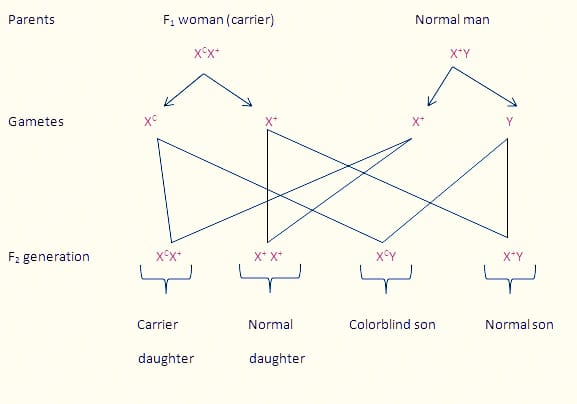
What is the criss-cross inheritance of traits?
Answer
589.2k+ views
Hint: It is also known as skip generation inheritance, and involves the transmission of genes.
Complete answer:
The patterns of inheritance, where a trait is inherited to the second generation through the carrier of the first generation are called criss-cross inheritance or skip generation inheritance. In simple words, it is the transmission of a gene from mother to son or father to daughter.
Natural selection favors diverse combinations of traits so that when the environment changes, there is a bigger chance of some individuals surviving.
Species that show X, Y sex determination (most mammalian species), go through the following two different mechanisms of addressing gene dosage:
- In early embryonic cells, random inactivation of one X or the other.
- Half down-regulation of gene expression from both the X chromosomes. (Drosophila)
Either way, traits encoded by genes on the X chromosome show X-linked inheritance. A criss-cross inheritance is produced when a female carries two recessive X-linked alleles, crossed with a wild-type male because the Y chromosomes from the male behave as null alleles. As a result, the recessive allele from the female parent is always expressed in the male offspring. However, her female offspring will receive one wild-type allele from the father.
The other, normally paired chromosomes are called autosomes.

Since females have two X sex chromosomes and males have an X and Y, mutations on the X chromosome in females may be masked by the presence of a normal allele on the second X. In contrast, a mutation on the X chromosome in males more often causes observable biological defects, as there is no normal X to compensate. Trait variations arising from mutations on the X chromosome are called 'X-linked'. Some well-studied examples of such disorders are:
1)Colour blindness.
2)Hemophilia.
Notes:
- Information from one gene is taken for the synthesis of a functional gene, this is called gene expression. The products are often proteins.
- Gene regulation is a wide range of mechanisms used by cells to increase or decrease the production of specific genes.
- Drosophila is a genus of flies, also called "small fruit flies", pomace flies, vinegar flies, or wine flies, linger around overripe or rotting fruit.
- About the characteristic of many species to A genetic mutation is a nonfunctional allele. Such mutations can cause a complete lack of production of the associated gene product or a product that does not function properly are caused by a null allele
Complete answer:
The patterns of inheritance, where a trait is inherited to the second generation through the carrier of the first generation are called criss-cross inheritance or skip generation inheritance. In simple words, it is the transmission of a gene from mother to son or father to daughter.
Natural selection favors diverse combinations of traits so that when the environment changes, there is a bigger chance of some individuals surviving.
Species that show X, Y sex determination (most mammalian species), go through the following two different mechanisms of addressing gene dosage:
- In early embryonic cells, random inactivation of one X or the other.
- Half down-regulation of gene expression from both the X chromosomes. (Drosophila)
Either way, traits encoded by genes on the X chromosome show X-linked inheritance. A criss-cross inheritance is produced when a female carries two recessive X-linked alleles, crossed with a wild-type male because the Y chromosomes from the male behave as null alleles. As a result, the recessive allele from the female parent is always expressed in the male offspring. However, her female offspring will receive one wild-type allele from the father.
The other, normally paired chromosomes are called autosomes.

Since females have two X sex chromosomes and males have an X and Y, mutations on the X chromosome in females may be masked by the presence of a normal allele on the second X. In contrast, a mutation on the X chromosome in males more often causes observable biological defects, as there is no normal X to compensate. Trait variations arising from mutations on the X chromosome are called 'X-linked'. Some well-studied examples of such disorders are:
1)Colour blindness.
2)Hemophilia.
Notes:
- Information from one gene is taken for the synthesis of a functional gene, this is called gene expression. The products are often proteins.
- Gene regulation is a wide range of mechanisms used by cells to increase or decrease the production of specific genes.
- Drosophila is a genus of flies, also called "small fruit flies", pomace flies, vinegar flies, or wine flies, linger around overripe or rotting fruit.
- About the characteristic of many species to A genetic mutation is a nonfunctional allele. Such mutations can cause a complete lack of production of the associated gene product or a product that does not function properly are caused by a null allele
Recently Updated Pages
Master Class 12 English: Engaging Questions & Answers for Success

Master Class 12 Business Studies: Engaging Questions & Answers for Success

Master Class 12 Economics: Engaging Questions & Answers for Success

Master Class 12 Social Science: Engaging Questions & Answers for Success

Master Class 12 Maths: Engaging Questions & Answers for Success

Master Class 12 Chemistry: Engaging Questions & Answers for Success

Trending doubts
Explain sex determination in humans with line diag class 12 biology CBSE

Explain sex determination in humans with the help of class 12 biology CBSE

Differentiate between homogeneous and heterogeneous class 12 chemistry CBSE

Dihybrid cross is made between RRYY yellow round seed class 12 biology CBSE

What is virtual and erect image ?

What is the Full Form of PVC, PET, HDPE, LDPE, PP and PS ?




